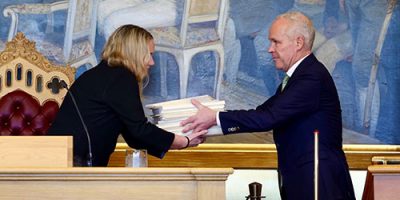Norway’s outgoing Conservatives-led government presented its last state budget proposal on Tuesday, but now it’s subject to lots of debate and alteration in Parliament. The new incoming Labour-Center government will want to put its mark on the budget, and then it will come under pressure from more left-leaning parties.

That suggests higher taxes on the wealthy in order to even out social differences. There will also be pressure to make the budget “greener” but it’s unlikely the incoming Labour Party-led government will dare to tap more funds from the Norway’s huge Oil Fund. The budget already has been balanced with NOK 322.4 billion from the country’s sovereign wealth fund. That amounts to 2.6 percent of the fund’s total assets, less than the 3 percent allowed, but still a lot of money since the fund is supposed to be saved for future pensions.
Outgoing Finance Minister Jan Tore Sanner of the Conservative Party noted during his state budget address to Parliament on Tuesday that the state budget is an example of “politics in practice.” It forces politicians to set priorities even though Norway is enormously fortunate to have its Oil Fund that literally can grease the budget. The vast majority of revenues needed to fund the welfare state still comes mostly from taxes, and many are set to rise no matter which parties hold government power.

The conservative government has already included some steep tax hikes of its own, possibly as an offensive strike against their political opponents. The government is proposing a whopping 30 percent hike in carbon taxes, for example, from NOK 591 per ton this year to NOK 766 per ton next year, and much higher taxes on both diesel and gasoline at the pump.
The theory is that “polluters pay,” while the tax hikes may also discourage driving. Taxes will also jump on all cars, by nearly 37 percent for fossil-fueled vehicles. Hybrid cars won’t get as much of a tax break as before unless they can operate on batteries over a distance of at least 100 kilometers. Electric cars can continue to lose some of their tax advantages, too, with the government proposing they should now pay just as high annual registration fees on their cars as everyone else (around NOK 3,000). They will get a slight reduction, however, on car insurance taxes.
Taxes on tobacco are rising again by as much as 6.5 percent and electricity taxes will only be slightly lowered despite all the calls for tax relief at a time of record-high electricity rates. Another tax hike that may be increased if the Greens Party gets any influence is the controversial airline seat tax, which may vary from NOK 80 to NOK 214.
One area of higher proposed taxation is on recreational property, second homes, and homes with market values of more than NOK 15 million. They’ve suddenly become subject to higher value assessments, which would in turn increase the amount of taxpayers’ taxable net worth.
The government thinks current taxable value on holiday homes (hytter), for example, is artifically low and should be raised, which would also raise personal fortunes subject to tax. Homes with a market value of more than NOK 15 million may see fully 50 percent of the value of over NOK 15 million suddenly included in calculation of net worth, instead of the 25 percent subject to fortune tax in less-expensive residences.
At the same time, though, the outgoing conservative government has proposed raising the deductible amount on taxable net worth to NOK 1.6 million per person, thus NOK 3.2 million for couples. The actual tax rate on remaining taxable net worth is set to remain at the current 0.85 percent.
These and other tax hikes are all aimed at making sure Norway has the resources for a sustainable welfare state. Spending proposals, meanwhile, include nearly NOK 53 billion for “district development,” possibly another offensive strike at the rural-oriented Center Party. Defense spending is due to rise again, to around NOK 69 billion, while NOK 800 million is earmarked for programs aimed at making sure more young Norwegians complete high school.
Another NOK 243 million was proposed to fund a new search and rescue helicopter base in Tromsø in Northern Norway, while NOK 2 billion was set aside for local governments around the country to spend in line with local needs. The outgoing government urges an end to Corona compensation programs, while the Labour Party want to keep funding them through the end of the year.
Debate over the state budget is due to begin next week, after Labour Party leader Jonas Gahr Støre presents his new government coalition platform and all the new ministers involved. Some commentators predict around NOK 10 billion may be shifted around, but there won’t be time to make massive changes in the budget. Next year the new government will get its first chance to present its own state budget, with all the political priorities it entails.
newsinenglish.no/Nina Berglund

